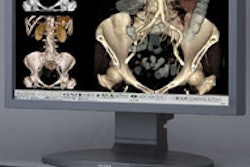ORLANDO, FL - The adoption of multiple information technology schemes, such as RIS, PACS, and hospital information systems (HIS), within healthcare institutions has crowded the radiology workspace with a collection of computer platforms and input devices. A scientific presentation at the Society for Computer Applications in Radiology (SCAR) annual meeting this weekend found that unifying RIS and PACS into a single interface provided gains in productivity and could improve patient care.
"The role of the radiologist is to interpret images in the correct clinical context, and this requires information that is not necessarily stored in the PACS database," Dr. Luigi Lepanto said. "Certain data is more easily accessible through the PACS, while other data is more easily accessible through the RIS."
Lepanto, a radiologist at Canada's Centre Hospitalier de l'Université de Montréal (CHUM) in Quebec, described research conducted at his institution in implementing a front-end RIS-PACS integration in a multivendor setting.
At CHUM, the PACS implementation at the radiologists' workstations includes two monitors for viewing the PACS software and a third monitor for the RIS and other applications. Both the RIS and the PACS are thick-client applications that run on separate PCs with separate keyboards and mice.
"Integration of the PACS and RIS applications at the client level was an objective early in the implementation phase; however, the challenge of bringing together different vendors and identifying the most appropriate configuration delayed its completion until two years after the PACS deployment," Lepanto said.
The CHUM team tested two configurations of RIS-PACS: one in which the RIS and PACS were installed on the same computer with a three-monitor display, the other in which the RIS and PACS applications resided on distinct computers with either shared or separate input devices.
"Although the use of a single computer or distinct computers was transparent to the radiologists, their preference was for a single mouse and keyboard device," Lepanto noted.
Both configurations were synchronized bidirectionally, Lepanto said. That is, when a user navigated a study worklist in the PACS, the RIS display would automatically refresh to the same patient and study. Navigation in the RIS, however, would synchronize to the PACS display only if invoked by a user from the RIS interface.
"This was preferred to automatic synchronization of the PACS display since the RIS serves as an adjunct to the image-viewing application," Lepanto said.
Lepanto noted that there were difficulties involved with running both the RIS and the PACS application on the same computer.
"The stability of each application is an issue if both are to reside on the same computer," he said.
In addition, because of differing upgrade schemes, interoperability of the programs can be affected, as well as their use of the same database engine.
"Frequent interruptions because one of the applications is inherently less stable can make the single configuration less appealing," he observed.
The researchers reported that the successful front-end integration resulted in several advantages. The department was able to obtain instant access to relevant history, demographic, and procedure information while viewing images on the PACS without having to make any additional keyboard or mouse entries. The synchronization strategy they deployed enabled the ability to navigate the RIS database without disrupting image viewing. And, the rapid review of images while signing reports electronically in the RIS ensured an increased quality of the final report, according to Lepanto.
The radiologists at CHUM reported that they saw a 59% increase in their efficiency with the integrated front-end RIS-PACS. Lepanto also noted that 60% of the radiologists were able to save more than 15 minutes each day through use of the front-end integration.
"Although implemented two years following initial deployment of PACS, front-end RIS-PACS integration would have been very useful in the early transition phase from film-based to filmless operation, since in cases where relevant priors were film-based, historical data present in the RIS database would have been instantaneously available while viewing images in the PACS," Lepanto said.
By Jonathan S. Batchelor
AuntMinnie.com staff writer
June 6, 2005
Related Reading
PDAs show promise for RIS/PACS portability, May 13, 2005
PACS plus paperless proves powerful, November 29, 2004
RIS and PACS -- together at last, June 11, 2004
RIS-PACS integration delivers improved interpretation, reporting times, December 1, 2003
RIS/PACS integration -- what is it and what are its benefits?, June 6, 2003
Copyright © 2005 AuntMinnie.com



















